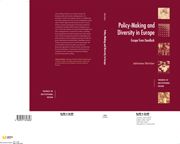Book contents
- Frontmatter
- Contents
- Acknowledgements
- 1 Escaping deadlock: policy-making in Europe
- 2 The context of subterfuge: diversity, fragmentation and the malleability of the European polity
- 3 The analytical approach and theoretical background
- 4 Market-making policy: transport and telecommunications
- 5 The provision of collective goods and the reduction of externalities: environmental policy
- 6 Market-correcting, redistributive policy: regional and social policy
- 7 Market-correcting, distributive policy: research and technology
- 8 Summary and conclusion: stalemate and subterfuge across policy areas
- References
- Index
3 - The analytical approach and theoretical background
Published online by Cambridge University Press: 22 September 2009
- Frontmatter
- Contents
- Acknowledgements
- 1 Escaping deadlock: policy-making in Europe
- 2 The context of subterfuge: diversity, fragmentation and the malleability of the European polity
- 3 The analytical approach and theoretical background
- 4 Market-making policy: transport and telecommunications
- 5 The provision of collective goods and the reduction of externalities: environmental policy
- 6 Market-correcting, redistributive policy: regional and social policy
- 7 Market-correcting, distributive policy: research and technology
- 8 Summary and conclusion: stalemate and subterfuge across policy areas
- References
- Index
Summary
The general explanatory approach underpinning this analysis claims that empirical policy patterns in distinct policy areas may be accounted for by examining the goal-oriented, rational-strategic interactions of public and private corporate actors with a stake in that policy area. Actors' interactions are guided by considerations of self-interest in that they attempt to achieve their goals, such as maximising their resources, in a specific context of institutional rules. While systems of rules, as factors, may both restrain and facilitate actors' choices, they do not determine them. There is always space for the individual actor's decision-making, accounted for by specific preferences, belief systems and cultural traditions (Mayntz and Scharpf 1995).
Interaction in a policy field may be understood as a process of bargaining and conflict among ‘consequential’ actors who dispose of diverse, but mutually important, resources – material, legal, informational, expertise and networking-related – which are exchanged and bargained for in a particular institutional context so as to reach a policy decision (Lauman and Knoke 1987). All actors concerned share a primary interest in the policy area, but pursue different specific goals.
If European policy-making is understood as the interaction of public and private corporate actors in an area of common policy interest, then such policy processes cannot be interpreted solely in terms of the national preference-formation and power considerations of member-state governments prior to EU bargaining processes (Moravcsik 1993).
- Type
- Chapter
- Information
- Policy-Making and Diversity in EuropeEscape from Deadlock, pp. 13 - 30Publisher: Cambridge University PressPrint publication year: 1999



